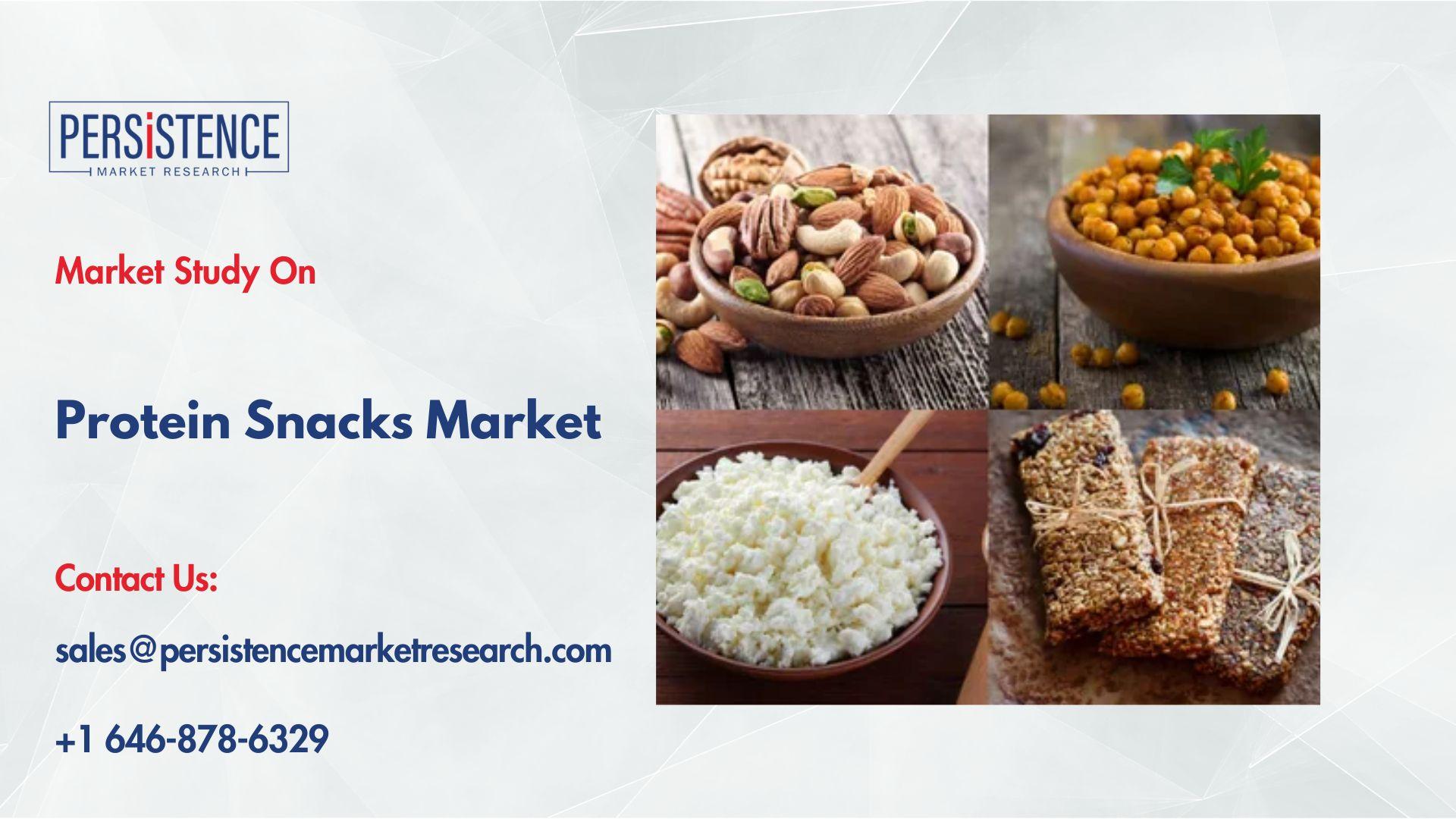Introduction
The global protein snacks market is undergoing a dynamic transformation, driven by shifting consumer preferences toward healthier, convenient, and functional food options. Once reserved for athletes and fitness enthusiasts, protein snacks have entered the mainstream, becoming a staple in the diets of busy professionals, students, seniors, and health-focused individuals. According to Persistence Market Research, the global protein snacks market is projected to rise from US$ 4,796.3 million in 2025 to US$ 8,624.3 million by 2032, registering a CAGR of 8.7% during the forecast period. This article explores key market trends, segmental insights, regional dynamics, and the competitive landscape shaping the future of protein snacks.
Market Dynamics
Key Drivers
One of the principal drivers of market growth is the growing inclination toward meal-replacement and appetite-control snacks. Consumers are increasingly adopting protein-rich snacks such as crisps, bars, puffs, and cookies that provide satiety, muscle recovery, and balanced nutrition. These products are especially favored during post-workout periods, hectic workdays, or travel.
Busy lifestyles and rising awareness about the importance of macronutrients for muscle gain and weight control are spurring the demand for convenient, nutrient-packed snack alternatives. For example, Premier Protein's Protein Puff, introduced in early 2025, caters to health-conscious consumers seeking a mid-day snack that satisfies hunger without excessive sugar. Meanwhile, Myprotein's Lean Cookie, offering 25g of protein under 200 calories, has gained traction among calorie-conscious consumers in Europe.
𝐆𝐞𝐭 𝐚 𝐒𝐚𝐦𝐩𝐥𝐞 𝐏𝐃𝐅 𝐁𝐫𝐨𝐜𝐡𝐮𝐫𝐞 𝐨𝐟 𝐭𝐡𝐞 𝐑𝐞𝐩𝐨𝐫𝐭 (𝐔𝐬𝐞 𝐂𝐨𝐫𝐩𝐨𝐫𝐚𝐭𝐞 𝐄𝐦𝐚𝐢𝐥 𝐈𝐃 𝐟𝐨𝐫 𝐚 𝐐𝐮𝐢𝐜𝐤 𝐑𝐞𝐬𝐩𝐨𝐧𝐬𝐞): https://www.persistencemarketresearch.com/samples/35351
Restraints
Despite positive growth, the protein snacks market faces significant challenges, particularly in terms of ingredient transparency. Consumers are increasingly scrutinizing products for artificial sweeteners and hidden sugars. Reports indicate gastrointestinal discomfort, including bloating from sugar alcohols like erythritol and maltitol, has deterred repeat purchases. A 2024 study published in the American Journal of Clinical Nutrition found that 28% of consumers avoid protein snacks for this reason.
Additionally, concerns about protein overconsumption, especially among moderately active individuals, are being raised. Consuming protein snacks on top of regular meals may contribute to excessive caloric intake, hindering weight management goals.
Opportunities
Emerging product categories are presenting exciting growth opportunities. Protein-infused yogurt parfaits, functional beverages, and hybrid formats such as protein pretzels are gaining popularity. Danone’s Activia Protein Parfait, launched in 2024, saw a 35% quarterly sales surge, indicating strong demand for multifunctional snacks that combine digestive wellness with protein enrichment.
Innovations in savory protein snacks, such as Snyder’s of Hanover’s protein-enhanced pretzel bites, provide a clean-label, plant-based alternative. Pulses such as chickpeas and lentils are being used to create allergen-free, high-protein snacks that appeal to vegan, gluten-free, and sustainability-focused consumers.
Category-wise Insights
By Type: Plant-based Dominance
The protein snacks market is segmented into plant-based and meat-based options. The plant-based category is set to dominate with a 62.6% share in 2025, driven by ethical, health, and environmental motivations. Flexitarianism is gaining traction, with more than 42% of global consumers identifying with this lifestyle.
Plant-based protein sources such as chickpeas, pea protein, brown rice protein, and soy-free blends are capturing consumer attention due to their digestibility and clean-label appeal. Meanwhile, meat-based protein snacks maintain relevance among ketogenic and paleo consumers who prioritize low-carb, high-protein diets. Sales of refrigerated meat snacks rose 11% year-over-year in the U.S. in 2024, led by turkey sticks and beef bites.
By Product Type: Protein Bars Lead the Way
Protein bars are anticipated to maintain the largest market share at 40.7% in 2025. These products offer a convenient and compact macronutrient-rich solution tailored for post-workout recovery, meal replacements, or travel snacks. Ingredient customization allows brands to target specific health outcomes such as gut health, energy enhancement, or muscle gain.
For example, Quest Nutrition launched a prebiotic-infused protein bar line, while Barebells introduced a caramel-cashew bar with 20g of protein and no added sugar, gaining popularity in Germany. Protein drinks, another fast-growing segment, are favored for their quick absorption and utility in sports nutrition and elderly care. Brands like Fairlife and OWYN have achieved significant sales spikes by promoting protein's role in immune support and muscle maintenance.
Emerging products include drinkable peanut protein, plant-based powders, and yogurt-based snacks, offering allergen-free and digestible alternatives to dairy and soy.
Regional Analysis
North America: Innovation and Functional Health Drive Demand
North America is projected to hold a 43.6% share in 2025, led by the United States. The region is witnessing continuous innovation in formats and formulations, catering to consumers using GLP-1 medications and those prioritizing weight control. Products like Reese's Peanut Butter Lovers Protein Bars and Oikos Protein Shakes are formulated for portion-controlled snacking and high-protein diets.
Egg protein is gaining ground due to its high bioavailability, fat-free composition, and suitability for individuals with lactose intolerance. Its applications in weight loss, sports nutrition, and senior nutrition are expanding rapidly.
Europe: Embracing Clean Labels and Novel Proteins
Europe's protein snacks market is characterized by demand for clean-label, allergen-free options. Corn protein is emerging as a popular alternative due to its hypoallergenic, gluten-free, and non-GMO profile. Products like Love Corn are growing in demand across snack aisles in the U.K. and Germany.
In Germany, protein-enriched sports bars remain popular, while the U.K. is seeing widespread usage of functional proteins in snacks targeting weight management and energy. Plant-based innovations and flavored protein crisps are becoming commonplace.
Asia Pacific: Whey and Plant-based Blends Take Off
The Asia Pacific region is experiencing rapid expansion in protein snack consumption, particularly whey protein isolate-based products. Enhanced technologies for flavor masking and microfiltration have made these products more palatable and suitable for ready-to-eat snacks.
India, in particular, is witnessing surging demand for roasted seeds, lentil chips, and sustainable plant-protein snacks. A growing fitness culture and rising awareness around nutrition are expected to further drive regional growth.
Competitive Landscape
The global protein snacks market is fragmented, comprising established food corporations and emerging start-ups. Key players are adopting strategies like product diversification, M&A activities, and clean-label innovations to stay competitive.
Key Companies
- Nestlé S.A.
- General Mills
- Kellogg’s Co.
- Quaker Oats Company
- PepsiCo Foods
- The Hershey Company
- Unilever
- Hormel Foods Corporation
- Abbott Nutrition
- B&G Foods, Inc.
Emerging brands like Orgain, RXBAR, and OWYN are leveraging niche positioning such as allergen-free, minimal-ingredient, and transparent labeling to build trust and brand loyalty.
Noteworthy Developments
- May 2025: YouTube personality MrBeast partnered with Jack Link’s to launch a global line of high-protein snacks, marking a new frontier in influencer-driven CPG branding.
- May 2025: Bel UK introduced Mini Babybel Protein with 5.2 grams of natural protein per serving, tapping into the demand for functional dairy snacks.
- November 2024: Bollywood actor Ranveer Singh co-founded SuperYou, launching India’s first protein wafer bar using fermented yeast protein, showcasing an intersection of celebrity influence and nutritional science.
Future Outlook
The protein snacks market is poised for continued evolution and robust growth through 2032. Key trends that will define its trajectory include:
- Expansion of personalized nutrition via customizable protein blends
- Rise in low-calorie, keto-friendly protein formats
- Greater emphasis on sustainable protein sourcing, such as pulse proteins and fermented ingredients
- Integration of digestive health, cognitive support, and energy functions into protein snack formulations
- Increased omnichannel presence, including e-commerce and DTC models
Conclusion
The global protein snacks market is no longer a niche; it is a vital segment in the evolving food and wellness ecosystem. Brands that stay agile in innovation, focus on clean-label transparency, and meet the diverse dietary needs of global consumers will be best positioned to capture long-term market share. With projected revenues crossing US$ 8.6 billion by 2032, the protein snacks industry is poised for exponential growth driven by health-conscious lifestyles, convenience, and scientific innovation.



